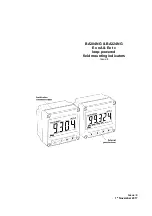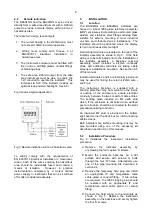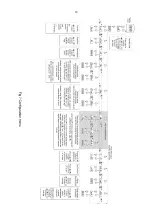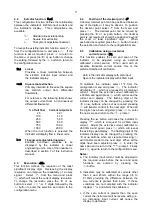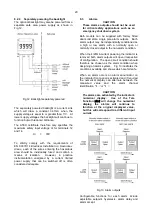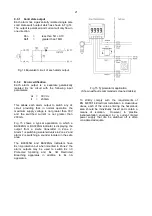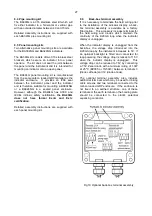
14
7.
LINEARISER
A sixteen segment, seventeen break-point (0 to 16)
lineariser may be selected in the
FunC
section of
the configuration menu. The position of each
break-point is fully adjustable so that the slope of
the straight line between break-points can be set to
compensate for input non-linearity, thus allowing
the indicator to display a non-linear process
variables in linear engineering units. Each break-
point must occur at a current greater than the
preceding break-point and less than the following
break-point, in the range 3.8 to 21.0mA. If this
requirement is not observed when configuring the
lineariser the indicator will display
FaiL
and the
configuration adjustment which produced the error
message will be ignored. Fig 8 shows a typical
linearised indicator characteristic.
Fig 8 shows a typical linearising characteristic
Selecting
Lin
in the
FunC
section of the
configuration menu activates the lineariser, this
does not change the configuration menu shown in
Fig 7, but the
CAL
and
5Et
functions are extended
as shown in Fig 9. As with a linear indicator,
calibration of the lieariser may be performed with
an external current source using the
CAL
function,
or with the internal reference using the
5Et
function.
The lineariser calibration is retained irrespective of
how the indicator function
FunC
is subsequently
changed. It is therefore possible to select and
deselect the lineariser without having to
reconfigure it each time.
The lineariser calibration may be reset to the
factory default settings without changing the
indicator configure using the
LtAb
function
described in section 6.11.
7.1
Lineariser calibration using an external
current source.
This method allows direct calibration of the
lineariser with an external current source and is the
preferred method when traceability is required. If
the exact system non-linearity is unknown, this
method also allows direct calibration from the
variable to be displayed. e.g. the output from a
level sensor in an irregular tank may be displayed
in linear volumetric units by filling the tank with
known incremental volumes and calibrating the
indicator to display the sum of the increments at
each break-point.
The number of break-point required should first be
entered using the
Add
and
dEL
functions. In both
these sub-functions the indicator initially displays
the current break-point and the total number of
break-points being used as shown below.
Display
Summary of function
Add
Add a break-point
Adds a new break-point before the
displayed break-point. The calibration of
existing break-points is not changed, but
the identification number of all
subsequent break-points is increased by
one.
dEL
Remove a break-point
Removes the displayed break-point and
joins the preceding break-point to the
following break-point with a straight line.
The identification number of all
subsequent break-points is decreased by
one.
To add a break-point use the
&
or
*
button to
select
CAL
from the configuration menu and press
(
which will result in the
Add
sub-function prompt
being displayed. To enter the sub-function press
(
which will reveal the current break-point and
the total number of break-points which have
already been entered. When adding a break-point
the insertion position can be selected using the
&
and
*
push buttons followed by
(
push button
to insert the additional break-point. In previously
uncalibrated linearisers each new break-point
should be added in front of the highest existing
break-point, if this sequence is not followed a
FaiL
message will occur in the
Pt5
function. See
example in section 7.1.1.

